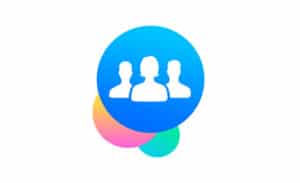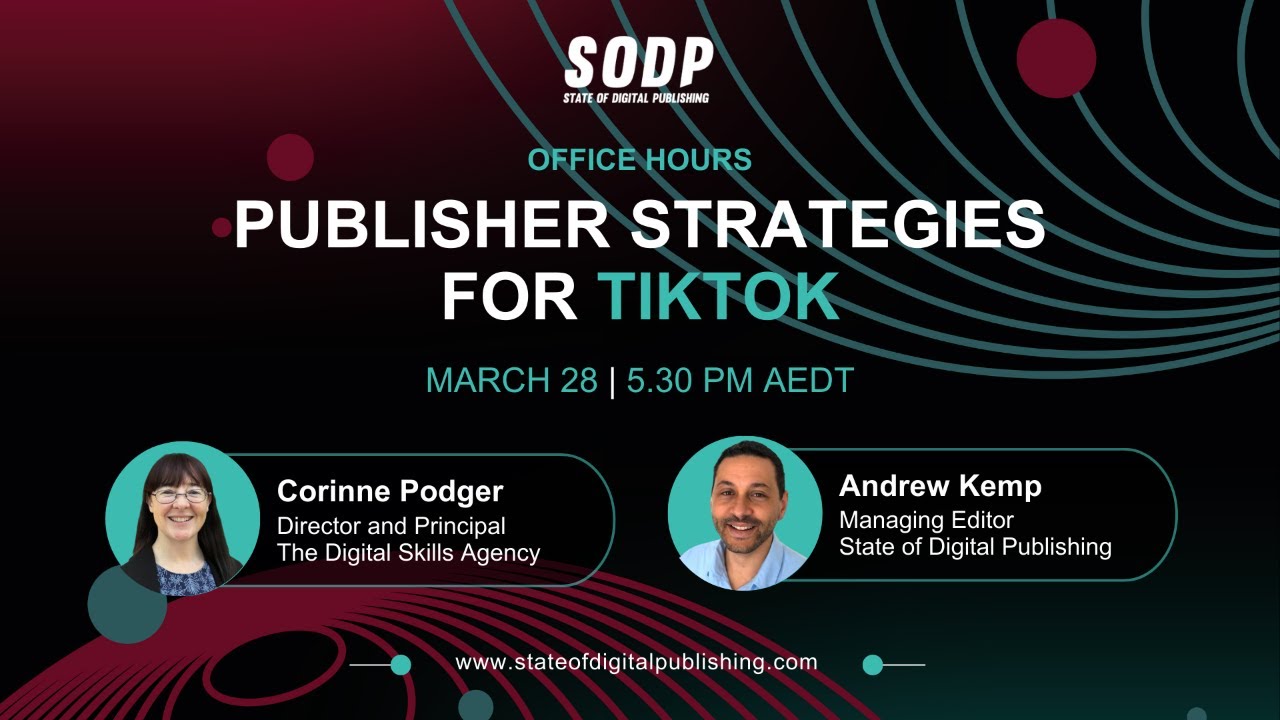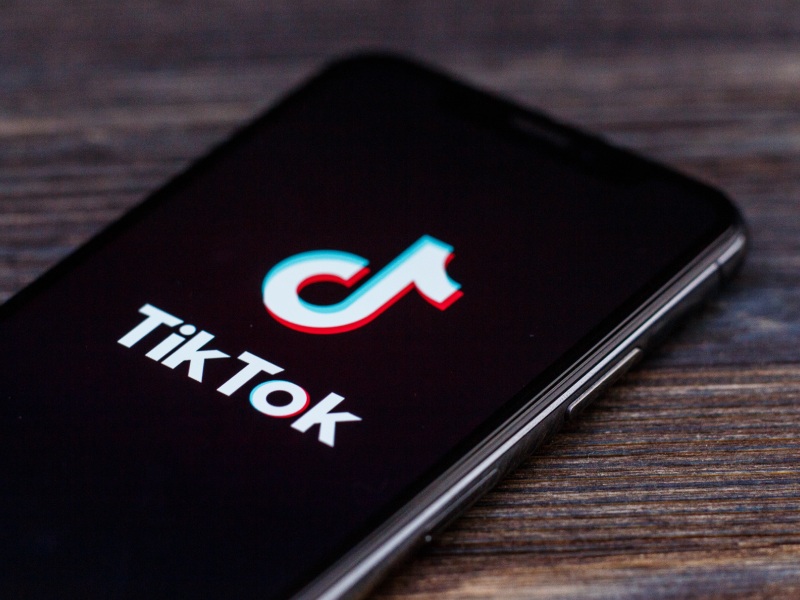Let’s think about the current challenges for those who work in newsmaking and the difficulties that they face while connecting with their public. The level of information that is consumed and shared online is massive, so the focus on how to keep the conversation going has become more important than ever.
Online communities play a big part in this scenario, since they offer users the possibility to participate and, mostly, engage deeply with brands and services. This provides a sense of belonging, a huge ally when a publisher wants to create an identity among their audience. What a great way to set ourselves apart from the competition. Miles apart.
There are many channels in the digital world that offer the option to create a space for communication, but there is a player that keeps up with the game and understands the importance of virtual bonds better than anyone else: Facebook.
Why Facebook Groups
With 2 billion active users each month, it is still the most widespread social media used in the world. It is no wonder that it remains as a crucial platform for publishers and digital media professionals, especially since 45% of US adults learn news and current events on this platform. What’s more: they also discuss debate and share the topics that interest them there.
On the wide range of tools that the social media giant has for companies, Facebook Groups is one that publishers in particular need to have on their radar. In order to better understand it and learn what you can do to take the most of it, we will analyze different examples of successful Facebook Groups created by prestigious magazines and newspapers.
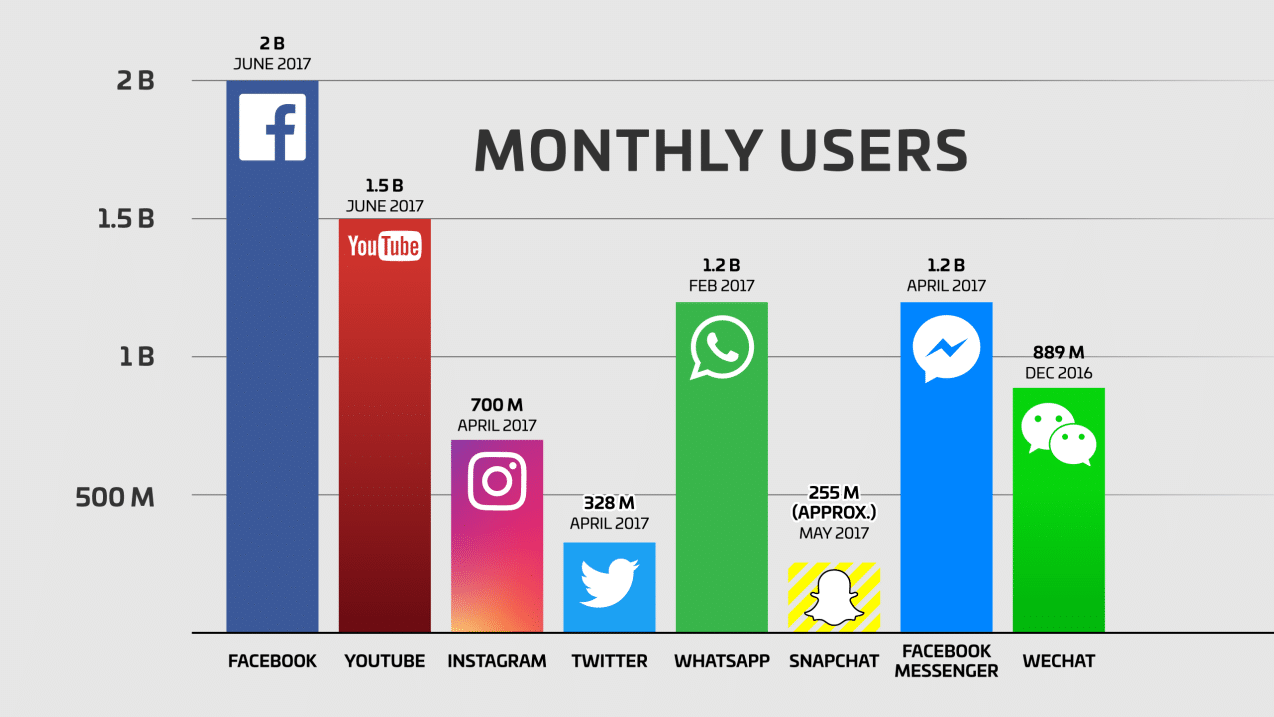
Source: Techcrunch
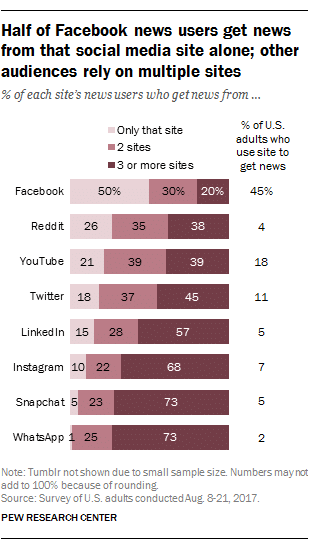
Source: Pew Research
Facebook Groups: building meaningful interactions
This is not the first time that publishers and digital media firms have been the main target of Facebook’s news feed algorithm updates. In fact, they’ve been experiencing a steep decline in their organic reach for more than a year.
Part of this can be attributed to Facebook’s attempt to assert that it’s not a media company. This has been the cry of the social media network after the scrutiny it received following allegations of influencing the outcome of the 2016 presidential elections in the US and the rise of fake news.
Zuckerberg also explained that the news feed algorithm update is a result of the feedback they’ve received from their users. In his post, he explained that users are complaining that “posts from businesses, brands, and media [are] crowding out” the posts and updates coming shared with their family and friends.
While Facebook’s latest update may put digital media professionals and publishers at a disadvantage, all is not lost.
Facebook pages are only one of the many tools that you can use to reach your readers on Facebook. Another way you can reach your readers without increasing your advertising budget is through Facebook groups.
Facebook groups vs. Facebook pages
Facebook groups are communities within this social media network where people can share ideas around a common interest, industry, or even a product. They work very much like Facebook pages in that you can post status updates, share videos, and promote your latest articles.
What makes Facebook groups different from Facebook pages is that the content published on Facebook groups aren’t pushed to the news feeds. Instead, members of a Facebook group receives a notification that there’s a new post, comment, or activity happening in a specific Facebook group.
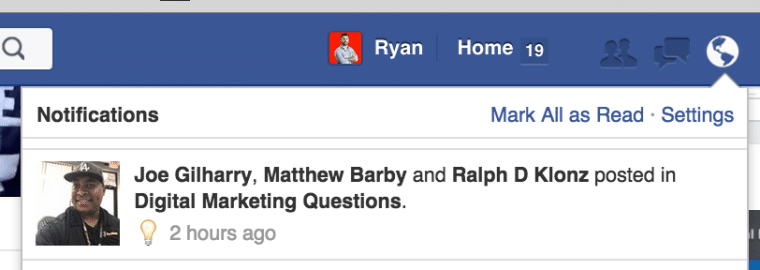
Source: Moz
There are over 1 billion users from around the world that use Facebook Groups, making this fertile ground for publishers and digital media professionals to capitalize.
Types of Facebook groups
Public groups
Public Facebook groups are very similar to Facebook pages in that anyone can just join automatically as soon as they’re found after doing a search.
Closed groups
Just like public Facebook groups, closed Facebook groups are those that can be found by your target audience when they do a search on Facebook. The difference is that they can’t just automatically join. Instead, they submit a request to join. The group’s administrator receives these requests and decides whether or not to approve the request.
Secret groups
As its name suggests, these kinds of Facebook groups are those you can’t find by searching on Facebook. You can only join a secret Facebook group by receiving an invitation from the administrator.
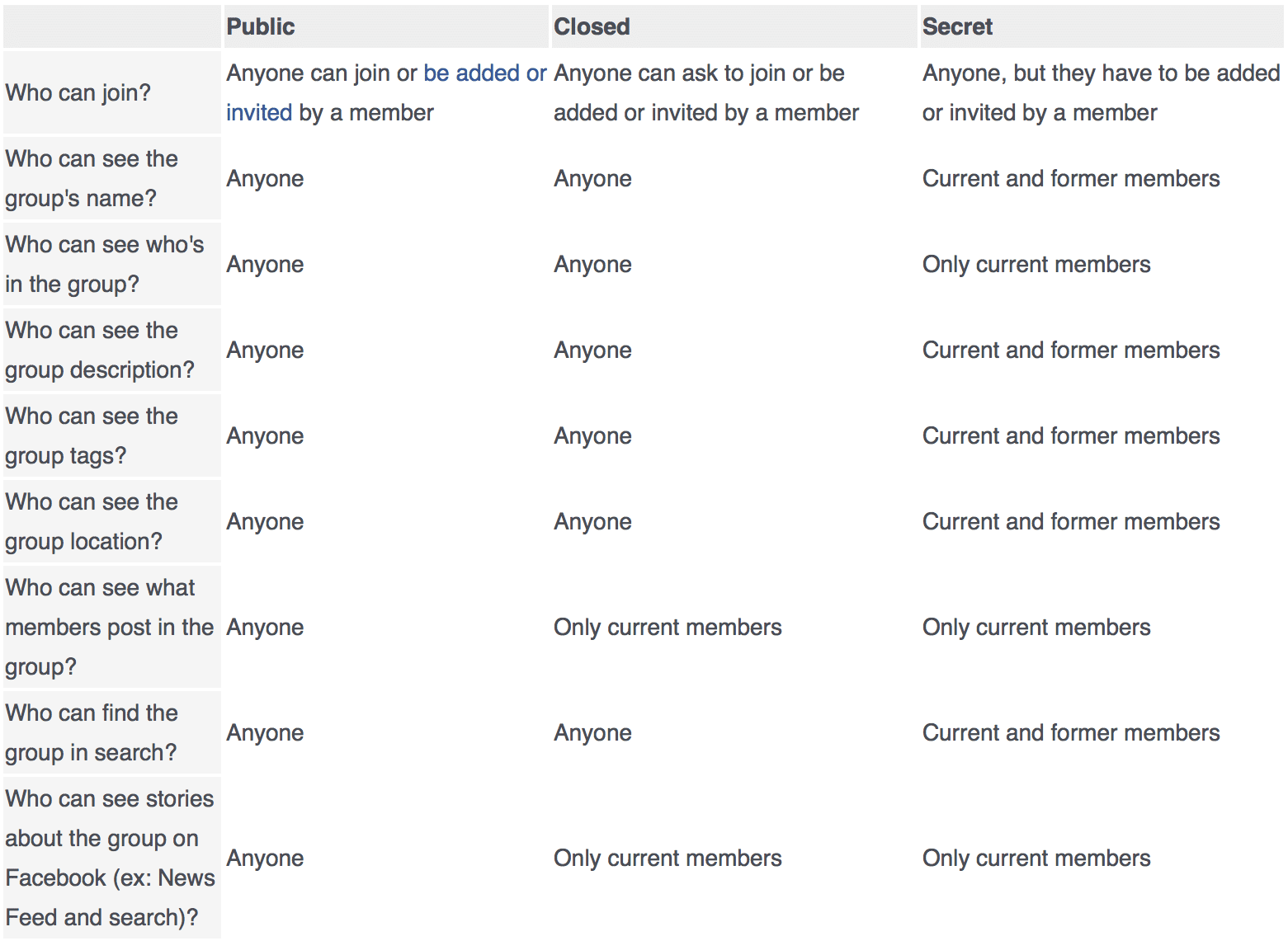
Source: Facebook
Joining or building?
There are two ways how you can use Facebook groups to promote your content.
The first is to join any one of the millions on Facebook. The second is to create one for your brand. Each of these has their benefits and disadvantages. Let’s take a closer look at the benefits of creating a Facebook group.
Benefits of creating your own Facebook group
Pre-qualify members
Unlike Facebook pages, you can pre-qualify those that want to join your Facebook group by asking them to answer some questions and make the decision whether or not to approve their request to join.
In some cases, you can use these questions by requiring someone wanting to join to either provide their email address, be an existing paid subscriber or download a content offer from a site.
As a result, the members that make up your Facebook group are those that are genuinely interested in receiving your content on a regular basis.
Platform to promote your content
A Facebook group gives journalists who lead or join the discussions. If you have a blog post or video that you’ve created in the past that would help answer the question left by a member in your group, you can include a link to this with your answer. Doing this can help you promote your previous blog posts, extending its life cycle.
Repository of ideas
Since the audience within a Facebook group is more targeted than a Facebook page, they also tend to be more receptive and engaged. Not only do you see more people jumping into a conversation, but they are also more open to start conversations by asking questions. These questions can eventually become a source of ideas and topics for future content.
Nurture and delight existing customers
Unlike emails, Facebook groups put your readers in a community where they can receive support from other existing customers. At the same time, you’re giving them a more efficient way to connect with you and get help, especially since 67% of consumers turn to Facebook to get answers and resolutions.
Inviting them to an exclusive group also gives them a sense of appreciation and belonging. They no longer see themselves merely as another a mere reader of your content but as a member of an exclusive clique, which can help build their loyalty to your brand.
Disadvantage of creating your own Facebook group
Creating your own Facebook group is that it’s time-consuming. You need to regularly monitor the activity within your Facebook group to ensure that the guidelines you’ve set are observed. On top of that, you need to also jump into the conversations to further encourage engagement from your members.
It’s clear to see that the benefits of creating a Facebook group for your brand outweigh the cons. In the next sections, you’ll learn the steps on how to build a Facebook group, link it to your Facebook page, and some best practices to observe.
Let’s take a look.
PostThis – By the Washington Post
As one of the pioneers in recognizing their reader’s need to feel part of the day-to-day discussions inside the newsroom, The Washington Post started PostThis, a group for its journalist and most loyal followers. Two reporters created it from their personal profiles before it was even possible for Facebook Pages to do so. What a vision!
The Washington Post team uses it to connect with their most dedicated fans. They provide an exclusive insight by sharing how they do their work or how they come up with story ideas, what allows the members the unique opportunity to engage in active discussions with staff.
Users can connect with others who have a common goal of understanding the work that goes into modern journalism, too. It is a fantastic way to make them feel like they belong to an exclusive group.
Women Who Travel by Condé Nast Traveler
A great example on how to capitalize a positive response to a specific editorial piece is Women Who Travel, by Condé Nast Traveler.
They were smart to identify that they had a niche of readers who shared a common interest and engaged deeply with the subject after the success of an editorial package published in March 2017 to celebrate Women’s History Month. The group is named after that edition and aims to connect women in a safe space where they can discuss and share information with like-minded experienced female travelers.
The group is also a place where editors source ideas for stories and get insights into what interests the audience. With over 71.000 members and a community that keeps growing and participating actively, this experience led to start the Women Who Travel podcast, hosted by two CNT editors, and even encouraged Condé Nast to replicate the strategy in other brands.
The New Yorker Movie Club
Once you have spotted a topic that your public is passionate about, it’s a good idea to think about the value you could bring to them by creating a Facebook Group and how yours could be different to other existing communities.
The New Yorker made its Movie Club Group special by having the active presence of one of its own movie critics, Richard Brody. In this sort of online book club for films, members and staff share weekly movie recommendations and discussions.
Brody often leads the conversations, but also invites users to start their own debates, what sets this community apart from other groups about the same subject.
Reel Women by Vanity Fair
To get an authoritative figure involved is a key element that other publishers have followed. Like Vanity Fair, who reached writer, actress, and producer Lena Waithe for a Q+A with their Reel Women group after she was featured in their March 2018 cover story.
The magazine was good at spotting a theme that addressed their reader’s needs for a profound discussion about the trials and tribulations of making it in the film industry as a woman.
Waithe provide a unique opportunity to members to ask about how she first broke into the industry, how is her creative process and, most important, what advice she had to other females.
This candid talk provided information that was specific and relevant to women in the industry that, ultimately, couldn’t be found anywhere else.
Money Talks by Bloomberg News
Once you find a topic that responds to your audience needs and have figured out how your group can add value to its members, how do you get your people to join and, mostly, engage?
Bloomberg News had identified that its public was interested in personal finance content, something already plenty covered in their website. But this material was not so easy to find for those who had a limit understanding of their finances and wanted to learn more. So when the Money Talks group was launched, the team came up with the idea of a 30-day Money Challenge, which consisted in sharing one actionable money-related tip every day for a month that was explained by visual or text overlays.
Along with call outs at the bottom of the stories that invited people to join the group, Bloomberg News was able to get users involved and participate in discussions about personal finance issues. Exactly what they needed.
Discussing Race in Boston by The Boston Globe
Sometimes reporters do not only reach for the usual sources for answers but to the general public as well.
The Spotlight team from The Boston Globe has a reputation that precedes them. In December 2017, the team worked on a seven-part series to take on a difficult question: is Boston a racist city? They believed that this exceeded the publication and needed to be addressed by the community, so they wanted to get the Bostonians involved. With a goal to facilitate debate regarding important topics in Boston, they created Discussing Race in Boston.
The involvement of the team was decisive. During the series, the responsibility for that day’s report would post a question related to the story of the day in their Facebook Group.
The staff started the fire, yet it was the members who kept the flame going and began their own conversations. They even created events to get together and discuss race issues, for which The Boston Globe sent reporters to participate on a personal level.
This is a fantastic example of how a publisher can reach to the community and create a space that is still used today to address sensitive problems. Reporters who cover social justice in Boston still share content on the group and actively participate.
How to create a Facebook group
Once you logged in your personal profile, click on the three dots on the upper right-hand corner and click on the Create a Group link.
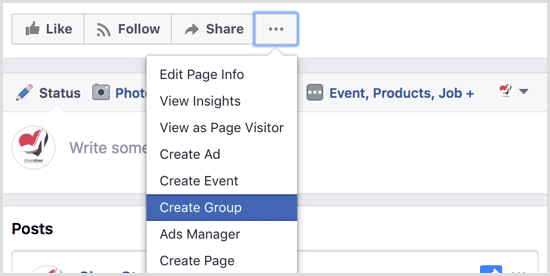
Source: Social Media Examiner
On the next screen, enter the name of the group that you want to create, the description, and choose the type of Facebook group you are going to create.
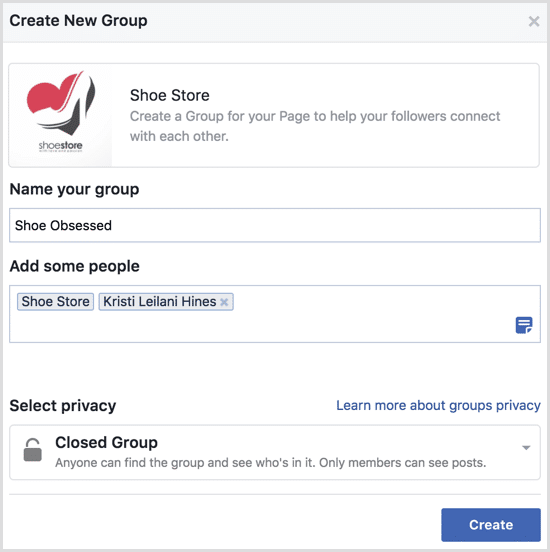
Source: Social Media Examiner
Make sure you write your Facebook’s description precisely so that those that find your group have a distinct idea what your group is all about, and how is this different from your Facebook page.
After you’ve added all the information about your Facebook group, the next step is to upload a cover photo.
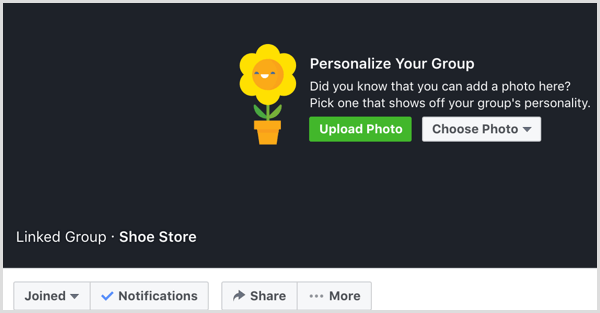
Source: Social Media Examiner
As with your Facebook page, make sure that the cover photo you use is catchy, crisp, and meets the guidelines set by Facebook.
The last step of creating your Facebook group is to add members to your group.
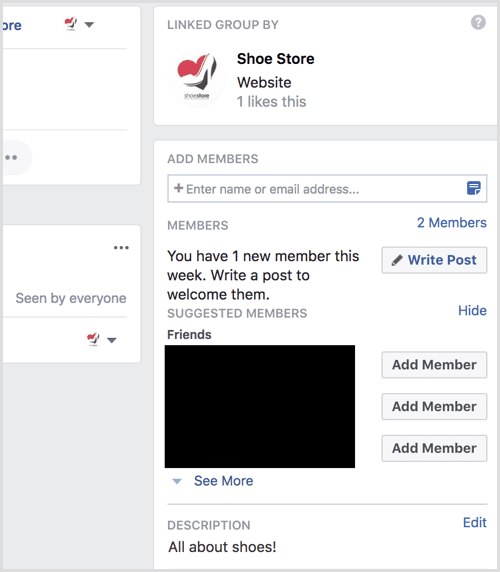
Source: Social Media Examiner
Since you’ll need to add at least one member in your group to complete the setup process, now is the time to add members of your marketing team that you’ve chosen to help you to manage your Facebook group.
Just like with Facebook pages, you can select the role of the different members that you add to the group whether they’ll be administrators or moderators.
Linking your Facebook group to your page
Now that you have your Facebook group set up, you can now link this to your Facebook page. Doing this helps promote your Facebook page to the members of your group, and vice versa. At the same time, you’re able to post and manage the group using your company’s Facebook page instead of your profile.
To link your Facebook group to your page, click on the More button in your group, and select Edit Group Settings option.

Source: Social Media Examiner
Click on the Link Your Page button, choose the page you want to link, and click the Link button. Your Facebook page will now appear in your group’s sidebar.
Populating your Facebook group with content
It’s a good idea to populate your Facebook group first with content before inviting new members. That way, when they arrive, they can start engaging by leaving comments.
That said, it’s crucial that you provide your new members with valuable and insightful content.
Don’t limit this to your latest blog post or product offers. Share curated content from credible sources that provide them with practical solutions that they can apply as soon as they finish reading them.
BuzzSumo, NewsWhip, Parse.ly or Crowdtangle are great tools for finding influencers or curated content. It shows you the trending articles based on your chosen target keywords. At the same time, you get a list of influencers operating within your industry and the content they’ve posted.
Curating and sharing content from influencers to your Facebook group can help you slowly get their attention, and build relationships with them.
A critical content to initially share at the onset is your Facebook group guidelines. This is a list of rules you expect your members to follow to stay within the group as more and more people request to join. That way, you protect your Facebook group from spammers and members that are looking to exploit your members by using this as a platform to promote their content for their personal gain.
Invite new members
Facebook groups give you more control on the members that join. Use this to your advantage by choosing the right people to invite to your group.
Content from our partners
There are several ways on how to do this. The first is by directly adding them to your group by clicking on the add member on your group’s sidebar.
While this may be the most accessible option, use this sparingly. That’s because those listed here are people connected to your personal Facebook profile. Use this to add members of your team to the group.
Another way to invite new members to your new Facebook group is to add a tab on your Facebook Page. To do this, click on the Settings icon on your Facebook page and select Edit Page.

Click on Add Tab, select Groups, and you’re done.
One important thing to remember is that when you add a new tab to your Facebook page, this is immediately placed in the bottommost part of the pile. To make sure that this is visible by those that follow or visit your Facebook page, rearrange the tab so by dragging the tab up so that it’s listed among the top four on your Facebook page’s sidebar.
You can also encourage new members to join your Facebook group through your website by either mentioning it on your site or by adding a social button.
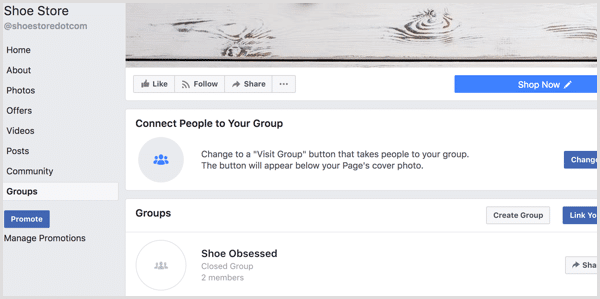
Encouraging engagement in your group
This is the essential part of creating a Facebook group since this will determine its success or failure. The last thing you want someone to leave your group after joining just because there’s no conversation happening among the members.
The first step to get your members interacting with you and with each other is by tagging new members to welcome messages you post. By introducing the new members to the group, you’re making them feel welcome and show that you’re genuinely pleased that they’re here.
Here are some other things that you can post on your Facebook groups to help spark engagement.
- Challenges. Challenges are quickly becoming favorite topics among Facebook groups, especially at the start of the year. It’s also a great lead generation tool to you if you’re running a service-based or consulting business because, at the end of the challenge, you can invite those that join to work more closely with you to take things to the next level.
- Live Q&As. Hosting a weekly live Q&A allows you to showcase your expertise and provide support to your members on their most pressing challenges. This is also one way for you to gather topic ideas for premium content that you can create as lead magnets on your website.
- Polls. People love expressing their opinions and appreciate it when given a chance to do so. Creating surveys around trending topics and news within your industry can help you do this. Just make sure that if you choose to use this to help promote engagement that you closely monitor the conversation happening here as it can quickly cause friction among your members.
Analyzing your Facebook group’s performance
Building and maintaining a Facebook group requires time and effort. You need to make sure that the resources you invest here are well-spent as well as pinpoint areas that need refining for you to achieve your set goals.
One way you can do this is through your Group Insights in Facebook. This is one of the newest tools Facebook released to help Facebook group admins to monitor the growth and engagement.
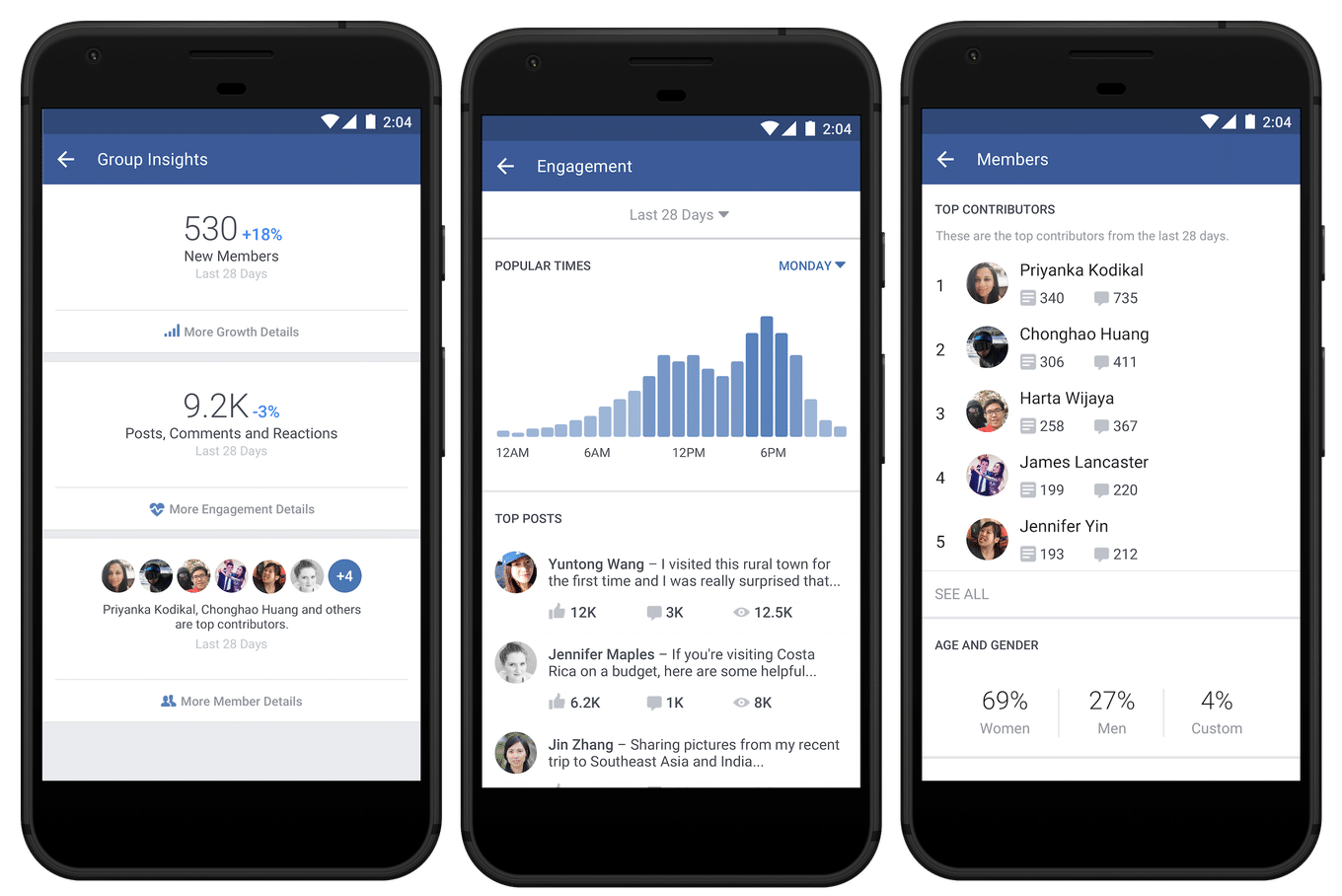
Source: Techcrunch
However, Facebook’s Insights that only shows analytics of groups that have at least 250 members. Alternatively, you can use a marketing automation software platform like eClincher. It can pull the analytics of your Facebook group regardless of its size on a real-time basis so that you can address any areas that need improvement to maximize your results.
Best practices in using Facebook groups
1. Make value top priority
Even though your primary goal for using Facebook groups is to generate leads and increase your readership, make sure that you focus your engagement efforts on providing value your group’s members. This is especially important when you’ve joined existing Facebook groups within your industry. Otherwise, the administrators of the group can see your engagement efforts to be overly promotional, and cause you to get kicked out from the group.
2. Don’t auto add
People don’t appreciate it when they’re automatically added to a group without their permission. The last thing that they can do is to leave your group. The worse is that they can report your group to the big guys over at Facebook, which can cause your group to get shut down. Make sure that if you add people to your group, make sure that you first get their permission to do so.
3. Use a marketing automation platform
Social media marketing automation platforms aren’t just for marketers. Digital publishers and media professionals can use this tool can make you more efficient in managing your Facebook group.
For starters, social media marketing automation allows you to schedule the posts in advance, so you don’t have to do this manually. At the same time, you’re able to receive and reply to comments. You can also create filters and alerts for certain types of content posted by members of the group in their comments or on the group’s wall so that you can quickly review this, and see if it meet your set guidelines.
4. Join unofficial groups of your brand
There’s a very good chance that there are Facebook groups created by your readers.
Joining these groups provides you insights on your brand’s online reputation. You can then use these ideas to improve your brand and create solutions that they’re looking for.
5. Promote the group in your stories
Many publishers get their member base by posting call-outs in their stories. They invite readers to continue the discussion in their Facebook Group since they value their input.
While doing so, relevance is very important: try to apply this action only when the theme of the story is related to the topic of the group. This will get you the right kind of profiles.
Some groups may reach the impressive amount of members, like Women Who Travel, and for other cases, it’s expected that their numbers may be lower, like Reel Women — a very specific problematic will get fewer people involved, and that’s ok. It’s a matter of quality, not quantity.
Conclusion
With the possibility to make your audience feel part of a community that has a strong relationship with your publication, Facebook Groups is a fantastic tool to gain insights and article ideas, at the time that will allow your editorial staff to promote their work in a more intimate way.
So pay special attention to the resonance of particular editorial topics, get your team involved and include Facebook Groups into your strategy. Challenge your staff to take the most of this opportunity and come with ideas of new content formats to include in your posts. Your readers will get closer to you message and will enjoy feeling part of what’s going on, something that will definitely set you apart from the competition.
Best of luck with your platform to engage your public!


